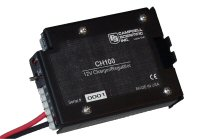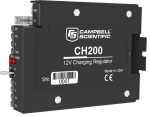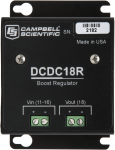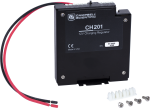This product is not available for new orders.

| Services Available | |
|---|---|
| Repair | No |
| Calibration | No |
| Free Support | No |
Overview
The CH100 is a charging regulator for 12-V rechargeable batteries. This regulator provides built-in temperature compensation to optimize battery performance. It is commonly used when a rechargeable battery is required for the application and the PS150 or PS12LA power supply (7 Ahr) does not contain enough reserve amp-hours for the power supply budget.
Read MoreImages










3D/CAD Files:
Detailed Description
The CH100 regulator connects the BP12, BP24, or other sealed rechargeable battery to an external charging source (e.g., solar panel, wall charger). The circuitry of the CH100 is similar to the PS100, but the CH100 does not include a rechargeable battery. The rechargeable battery must be capable of accepting recharge from a trickle-charge source.
The CH100 controls the current flowing to the battery and prevents the battery current from flowing to the charging source.
Compatibility
Please note: The following shows notable compatibility information. It is not a comprehensive list of all compatible products.
Additional Compatibility Information
Batteries
The CH100 is typically used with the BP12 and BP24 battery packs.
Specifications
| input Voltage (CHG Terminals) | 15 to 28 Vdc or 18 Vac RMS |
| Charging Output Voltage | Temperature-compensated float charge (for 12 Vdc battery) |
| Charging Current Limit | 1.2 A (typical) |
| Power Out (+12 Terminals) Voltage | Unregulated 12 Vdc from battery |
| Length of Red and Black Wires | ~30 cm (12 in.) |
| Dimensions | 10.2 x 7.0 x 3.9 cm (4.0 x 2.8 x 1.5 in.) |
| Weight | 158 g (5.5 oz) |
Quiescent Current |
|
| Charge Source Present | 3 to 5 mA |
| No Charge Source Present | 0 mA |
Documents
Product Brochures
Technical Papers
Frequently Asked Questions
Number of FAQs related to CH100: 1
-
The PS100 (and CH100) are limited to 1.2 A of input. Because the SP20 20 W solar panel generates 1.17 A, that single panel represents a practical limitation to the input. For panels that generate current greater than 1.2 A, consider the PS200, Smart Power Supply and Charge Controller, or CH200, Smart 12 V Charging Regulator, for up to 3 A of input, or pn 18529, 10 A, 12 V, Morningstar Regulator, which is capable of accepting 10 A of input.
Generally, it is not recommended to connect more than one panel at a time. Differential shading can cause issues, such as the shaded panel acting as a current sink.



